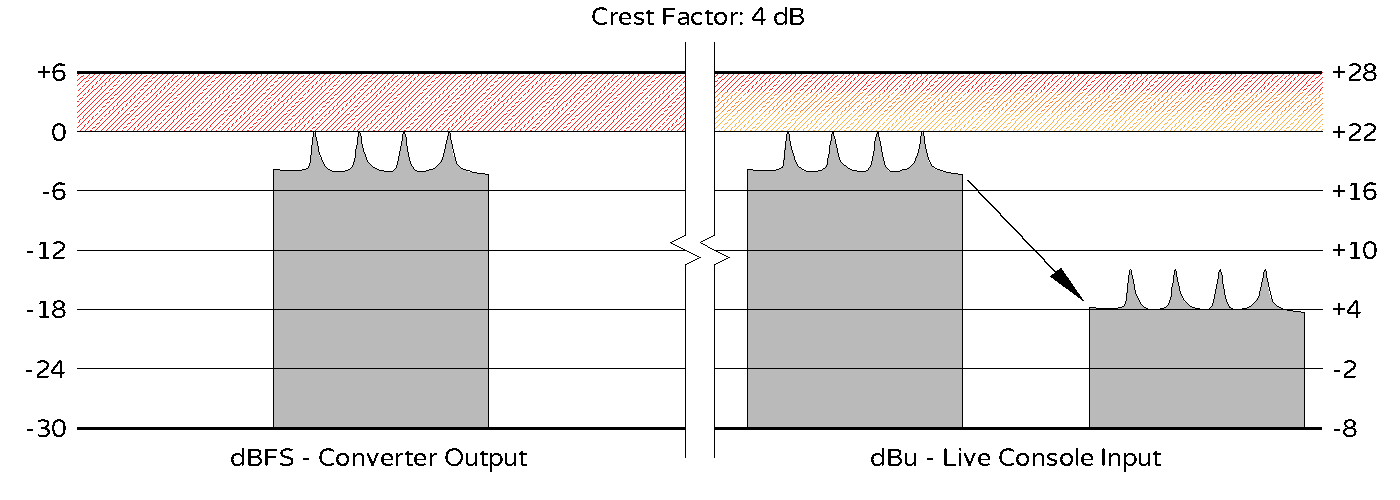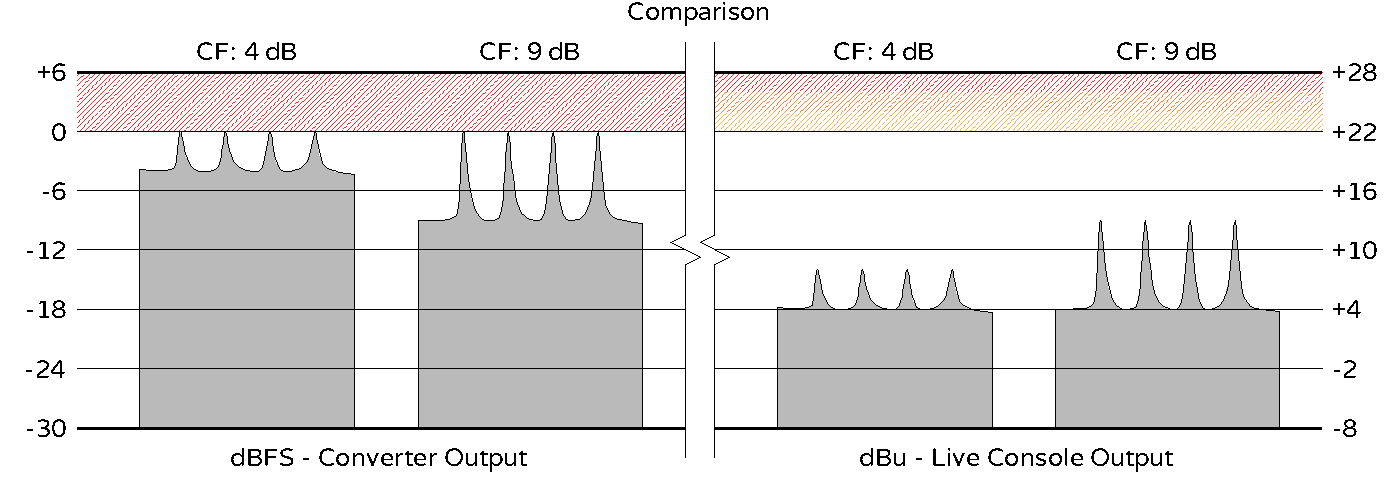Why You Should be Mixing and Mastering Your E.D.M.* Tracks with Higher Crest Factor**
Ok, let's get a few things out of the way right off the bat: 'E.D.M.' and 'Crest Factor' are likely to be viewed as contentious terms, so let me tell you exactly what I mean by them.
*E.D.M. Electronic. Dance. Music. That's how simple that explanation should have to be, but let me elaborate a bit, just in case. What I don't mean is the wave of vaguely electro-house tinged, big-room, festival music that recently swept North America. What I do mean is music, made via electronic means, with the intent of people dancing to it. This covers everything from house, techno, and trance to drum n' bass, dubstep, hip-hop and beyond (including all the myriad sub-genres). Basically, anything meant to get bodies moving in a bar, club, warehouse, field, parking lot, stadium, etc.
**Crest Factor. Ok, to be fair, unless you're Paul Frindle you're probably not going to call me out on this, but I have a great deal of respect for Paul, so let me clarify. What I'm getting at is the difference, in dB, between the peak and average levels of your music. This is called many things: peak to average ratio, peak to loudness ratio (PLR), peak to short-term loudness ratio (PSR), micro-dynamics (or just dynamics), dynamic range (DR), crest factor, and probably a few others I'm forgetting. All these terms have slightly different technical (or non-technical) definitions, but point at the same concept.
Ok, good. Now that that's out of the way let me explain to you why, in my humble opinion, we should all be mixing and mastering our electronically-composed-and-produced-music-which-we-hope-people-will-dance-to (E.D.M.) with a higher peak to average ratio (or crest factor, or ...whatever...)
The Loudness Thing
Oh man, where to even start with this. The whole loudness thing is such a red herring, but unfortunately without a little background it's easy to get swept up by many of the claims about why intrinsic loudness is necessary. Stop me when you've heard (or maybe even made) one of the following arguments: "It needs to be loud so that it will bump in the club", "It needs to be loud so that it sounds as good as all the other big-name E.D.M. tracks it gets played back to back with", "It needs to be loud because that's just part of the sound of E.D.M.". Et cetera. Et cetera.
Two of these are relatively easy to address, while one definitely benefits from some slightly more in-depth understanding. Let me address the easier ones first.
that's just part of the sound of E.D.M.
I'm calling bull$h!t on this one. There is so much E.D.M. out there that boldly contradicts this. "Like what", you ask? Oh, I don't know, how about anything that has ever been pressed to vinyl? Remember, for a long time vinyl was one of the dominant ways E.D.M. was played, and I've heard more than one vinyl mastering engineer say that E.D.M. was largely responsible for keeping vinyl alive during the heyday of the CD. Need more examples? How about a good deal of both deadmau5 and Daft Punk's discographies, or the new Plastikman album EX. The list goes on.
it needs to compete with all the other big-name E.D.M. tracks
You do realize that no matter how you DJ, you have gain control over individual songs, right? If you're totally in-the-box (e.g. Ableton, Traktor without a mixer, etc.) this may mean turning the louder songs down a bit. Trust me, as long as you're not coming out of the headphone jack on your laptop the sound guy can make everything plenty loud (more on this later). If you are coming out of the headphone jack, well, maybe it's time to get a modestly priced interface. If you're using Traktor, Serato, CDJs, etc. with an external mixer, you have both the input gain and channel fader to balance the loudness of the tracks you're playing. If you're not doing that, then you've got a few more things to learn about DJing.
It needs to bump in the club
Ok, this is where a little background information comes in really handy.
I get it. You're worried that if it doesn't sound loud enough at a normal playback volume on your regular home monitors, or maybe even your laptop or phone (*cringe*), it won't be loud enough in the club. Here's the thing. The amount of power that's being used for amplification is drastically different. Think about it: a live PA system, like the ones used in most bars and clubs (never mind the huge line arrays used for festival stages), has to have enough power to make even the most dynamic material playback at a reasonable listening volume for the venue. So what is that 'most dynamic material' that needs to be supported? A live band! A live mix of a band with drums, bass, a few guitars, keyboards, and vocals can easily have a crest factor of 14-16 dB, if not more. This is why most live consoles have at least 18 dB of headroom over 0 VU. The live sound engineer (aka FOH engineer) will mix with a target average level of around 0 VU (+4 dBu), if not a bit lower, and have the amplification system set up so that it produces the desired loudness when it receives average levels in that range. The amplification system will also be designed with enough headroom so that when it receives high peak levels from things like kick drums, bass slaps, loud vocal phrases, etc. it can pump them out without being driven into clipping.
So what does all this mean for you in E.D.M. land? It means that if your track has been mastered with an RMS level of about -4 dBFS (frighteningly common), your interface is calibrated with +4 dBu equal to -18 dBFS (also common, not necessarily frightening), and your output isn't attenuated at all (it probably isn't), the FOH engineer will turn you down by about 14 dB. Now your peaks are at +8 dBu in a system that can handle peaks of at least +22 dBu (likely closer to +25 or +27 dBu), meaning there's at least 14 dB of completely unused headroom.

To tie this back in to the original point, if your song is mastered 5 dB softer, with an RMS level around a much more reasonable -9 dBFS, it means: a) you can turn all the ultra-loud songs in your set down to match your more reasonable song, b) the FOH engineer will still turn you down by 9 dB, and c) there will still be 9 to 14 dB of unused headroom in the system.
Confused by all the dBFS, dBu, VU, peak, and RMS numbers flying around? Still worried it won't bump in the club? Don't be. There really isn't room to go into how all the different electrical and digital levels correlate here, but I promise there's no sleight of hand going on. Any reasonably mastered song will be able to play plenty loud on a reasonably designed club system.

the headroom thing
Alright, home stretch. Hopefully by this point I've convinced you that your E.D.M. doesn't need to be stupid loud just to measure up in the club, but I have yet to make my case for why you should actually be striving to mix and master it with slightly higher crest factor values. Let me do just that.
I'm sure you've heard that when it comes to perceiving loudness, we humans rely much more on average levels than peak levels. While this is true, it doesn't mean that peak level is irrelevant. It's peak levels that provide much of the visceral feel and impact of music, especially when played at the higher sound pressure levels you're likely to find in a club. You want your drums and drops to hit hard? Give them some headroom to really extend into.
One analogy I like to make is to compare the 'punch' of a drum to an actual punch (I am in no way advocating violence here). First imagine delivering a punch, but with your fist starting just a couple inches away from your intended target. As hard as you try, it's just not going to deliver that much power (unless maybe you're Bruce Lee, but face it, you're not). Now imagine pulling your fist back to your shoulder and landing a punch on your target which is now 18 or so inches away. There's a lot more power behind that second punch. Well the same is true with sound. When your drums can only extend 4 dB or so above your average level, sure you can tell they're there, but the impact is lost. Give them 8 or 10 dB to extend into, and the story begins to change.
Remember those 18 to 23 dB of headroom in a live PA system that we talked about? Well this is where we can really put them to work for us. I'm not saying we need to use all that headroom, after all we're not trying to go M. Bison Psycho Crusher on our audience.

By using 8 or 10 dB of that available headroom though, we can create tracks that play back just as loud as their hyper-compressed and limited counterparts (providing the DJ is doing their job), but that hit our audience with much greater visceral impact and frankly are that much more likely to get them moving.
Try it, I think you'll be pleasantly surprised!
